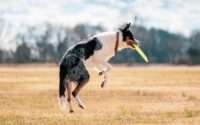Are Dogs Ticklish? Find Out the Surprising Truth!
As dog enthusiasts, we’re always on the lookout for new ways to deepen our connection with our beloved four-legged friends. One intriguing topic that often sparks curiosity is whether dogs experience the delightful sensation of tickling. We’re all familiar with the laughter and playfulness that tickling brings us, but what about our canine companions?
In this captivating exploration, we’ll dive into the scientific realm of tickling, shedding light on its connection to dogs. Join us as we unravel the mysteries, uncover the potential benefits, and uncover any caveats that come with tickling your furry companion. Get ready to embark on an enlightening journey that will leave you with a deeper understanding of the fascinating world of ticklish dogs.
The Science of Tickling
Tickling is an intriguing phenomenon that involves a complex interplay between our nerves and brain. It’s that delightful sensation we experience when lightly touched, often resulting in laughter or uncontrollable movements. While tickling has long been thought of as a uniquely human experience, recent research has shed light on the existence of tickling behaviors in various animals, including rats and monkeys.
But what about dogs? Can they also experience ticklish sensations? While it’s challenging to provide a definitive answer, there is compelling evidence to suggest that dogs may indeed be ticklish. Similar to humans, dogs have sensitive skin that contains specialized sensory receptors designed to respond to touch.
These receptors serve a vital role in transmitting signals to the brain, which then interprets the sensation as pleasurable or unpleasant. However, it’s important to note that dogs may not experience tickling in the exact same way we do. Dogs have a different threshold for touch, and they may not respond to light, tickling touches in the same manner that humans do.
Do Dogs Have Ticklish Spots?

Understanding your dog’s anatomy and behavior is key when it comes to tickling them. Dogs do have sensitive skin and fur that can potentially be ticklish, but it’s important to remember that each dog is unique, and their response to tickling may vary.
There are some common areas where dogs may be more ticklish, such as the ears, belly, and paw pads. These regions tend to have a higher concentration of sensory receptors, which can make them more sensitive to touch. When gently stimulated in these areas, some dogs may exhibit a pleasurable response or even show signs of enjoyment.
However, it’s crucial to recognize that not all dogs will enjoy being tickled, even in these commonly ticklish spots. Just like humans, dogs have their own preferences and sensitivities. Some may revel in the sensation and respond with excitement and joy, while others may find it uncomfortable or even stressful.
To determine if your dog enjoys being tickled, pay close attention to their body language and behavior. Look for signs of relaxation, such as a loose body, wagging tail, and soft eyes. If your dog shows any signs of distress, agitation, or attempts to move away, it’s essential to respect their boundaries and discontinue the tickling.
How to Tell if Your Dog is Ticklish
As a responsible dog owner, understanding your dog’s body language and behavior is essential in determining whether they enjoy being tickled. Recognizing the signs that indicate your furry friend’s level of comfort is crucial for creating positive and enjoyable experiences. Here are some guidelines to help you gauge whether or not your dog is ticklish.
- Relaxed Body Language: A dog that is enjoying being tickled will exhibit relaxed body language. Look for loose muscles, a neutral or wagging tail, and a generally calm demeanor. These are positive indications that your dog is likely enjoying the tickling sensation.
- Tail Wagging: A wagging tail is often a sign of happiness and enjoyment in dogs. If your dog’s tail is wagging while you tickle them, it suggests that they are enjoying the interaction.
- Playfulness: Tickling can elicit a playful response in dogs. If your dog engages in playful behavior during or after being tickled, such as bouncing around, inviting more interaction, or play-bowing, it indicates that they find the experience enjoyable.
However, it’s equally important to be aware of signs that your dog may not appreciate being tickled. If you notice any of the following behaviors, it’s crucial to stop tickling and reassess the situation:
- Tense Body Language: If your dog’s muscles become stiff, they may be showing signs of discomfort or stress. Look for a hunched posture, rigid body, or tensed facial expressions.
- Growling or Vocalizations: If your dog growls, whines, or shows signs of vocal distress, it’s a clear indication that the tickling is not enjoyable for them. These vocalizations are their way of communicating their discomfort or desire for the interaction to stop.
- Attempts to Move Away: Dogs have their own personal boundaries, and if they try to move away from you during tickling, it’s a signal that they would prefer not to be touched in that manner. Respecting their space and giving them the opportunity to retreat is important for maintaining their comfort.
Remember, safety and respect are paramount when tickling your dog. Avoid sensitive areas such as the genitals or face, as these can be uncomfortable for them. Start with light, gentle touches and gradually increase the pressure to assess your dog’s comfort level. Continuously monitor their behavior, and if they display any signs of unease or excessive stimulation, stop the tickling immediately.
The Benefits and Risks of Tickling Your Dog
Tickling can be a delightful and playful way to connect with your furry companion, but understanding the potential benefits and risks is essential. At BarkLikeMeow, we believe in promoting the well-being and happiness of dogs, and that includes ensuring that tickling is a positive experience for both you and your four-legged friend.
Benefits of Tickling:
- Bonding and Affection: Tickling can serve as a form of physical affection that strengthens the bond between you and your dog. It can create a sense of closeness and trust, fostering a deeper connection.
- Playfulness and Joy: Tickling can elicit joyful and playful responses in dogs, leading to moments of shared happiness and laughter. It can enhance their overall well-being and contribute to a positive and enriching environment.
- Sensory Stimulation: Gentle tickling touches can provide sensory stimulation for your dog, activating their sensory receptors and potentially contributing to their overall sensory experience and mental stimulation.
Risks of Tickling:
- Overstimulation and Anxiety: Some dogs may become overstimulated by tickling, leading to anxiety or even aggressive behavior. It’s crucial to monitor your dog’s body language and behavior closely to ensure that they remain comfortable and relaxed throughout the interaction.
- Individual Preferences: Just like humans, dogs have their own preferences and sensitivities. Some dogs may not enjoy being tickled at all, and it’s important to respect their boundaries and preferences when it comes to physical touch.
- Sensitive Areas: Tickling sensitive areas such as the genitals or face can be uncomfortable or even painful for your dog. It’s crucial to avoid these regions during tickling to ensure their comfort and well-being.
To make tickling a positive experience for your dog, consider the following tips:
- Read Your Dog’s Cues: Observe your dog’s body language and behavior during tickling. Look for signs of relaxation and enjoyment, such as loose muscles, wagging tail, and soft eyes. If your dog displays any signs of discomfort or stress, discontinue the tickling immediately.
- Respect Boundaries: Each dog has their own personal boundaries. If your dog shows any signs of wanting to stop the tickling, such as moving away or vocalizing their discomfort, respect their cues and give them space.
- Safe and Gentle Touch: Practice safe and gentle tickling techniques. Start with light touches and gradually increase pressure if your dog appears to enjoy it. Avoid sensitive areas and focus on areas that your dog finds pleasurable, such as the back or chest.
By understanding your dog’s individual preferences, respecting their boundaries, and practicing safe and respectful tickling, you can create positive and joyful interactions that deepen your bond and create cherished memories with your furry companion.
Alternatives to Tickling Your Dog

If tickling isn’t your dog’s cup of tea or if you’re seeking alternative ways to bond and engage with your furry companion, there are numerous fun and safe activities that can strengthen your connection. Here are some other possible activities that cater to your dog’s preferences and create joyful experiences for both of you.
- Play Fetch: Playing fetch is a classic and enjoyable game that taps into your dog’s natural instincts. Whether it’s a game of fetch in the park, a backyard toss, or even a swim in the water, this activity provides mental stimulation, exercise, and a chance for you and your dog to bond over a shared pursuit.
- Walks or Runs: Going for a walk or run with your dog not only provides physical exercise but also offers opportunities for exploration and quality time together. It allows you both to enjoy the outdoors, breathe in fresh air, and appreciate the world around you.
- Training and Tricks: Engaging your dog in training exercises and teaching them new tricks can be a rewarding and mentally stimulating experience. It strengthens the bond between you and your dog while enhancing their obedience and mental agility. You can start with simple commands like “sit” and “stay” and gradually progress to more advanced tricks based on your dog’s abilities.
Remember, every dog is unique, so it’s important to understand and respect their individual needs and preferences. Some dogs may thrive on physical play and high-energy activities, while others may prefer more relaxed and low-key interactions. Pay attention to your dog’s cues and adjust your activities accordingly to ensure they have an enjoyable and fulfilling experience.
Common Misconceptions About Tickling Dogs
There are a few misconceptions about tickling dogs that deserve clarification. It’s important to provide accurate information to ensure the well-being of dogs and strengthen the bond between dogs and their owners.
- Tickling as Punishment or Dominance: Tickling should never be used as a form of punishment or dominance. It is important to approach tickling as a positive and playful interaction that fosters connection and reinforces positive behaviors. Using tickling as a means of punishment can confuse and distress your dog, leading to potential behavior issues.
- Not All Dogs Enjoy Tickling: Dogs, just like humans, have individual preferences and sensitivities. Not all dogs appreciate being tickled, and it is essential to respect their boundaries and preferences. Pay close attention to your dog’s body language and behavior during tickling. If they display signs of discomfort or overstimulation, it is crucial to stop the tickling and find alternative ways to interact with them.
- Tickling as a Cure for Anxiety or Aggression: While tickling can enhance the bond between you and your dog through positive physical affection, it is not a remedy for anxiety or aggression. If your dog is experiencing anxiety or demonstrating aggressive behavior, it is recommended to seek assistance from a professional trainer or veterinarian who can provide proper guidance and support tailored to your dog’s specific needs.
By understanding these misconceptions, you can ensure that your interactions with your furry companion are based on respect, trust, and a genuine understanding of their individual preferences.
Conclusion
In conclusion, while the ticklishness of dogs remains somewhat of a mystery, it is crucial to prioritize the well-being and comfort of our furry friends. At BarkLikeMeow, we always advocate for responsible and respectful interactions with dogs, including tickling.
As a loving dog owner, it’s essential to be attentive to your dog’s behavior and preferences. Not all dogs will enjoy being tickled, and it’s important to respect their individual boundaries and comfort levels. By paying close attention to their cues and responses, you can ensure that your interactions are positive and enjoyable for both of you.
Remember, there are numerous other ways to bond and engage with your dog that go beyond tickling. Going for a leisurely walk, engaging in a game of fetch, or simply sharing quiet moments of snuggles and affection on the couch can be equally meaningful and rewarding.
By approaching interactions with kindness, respect, and an understanding of your dog’s preferences, you can cultivate a deep and lasting connection that brings joy and fulfillment to both of your lives. Together, let’s create a world where every dog feels loved, cherished, and understood.
Frequently Asked Questions
Q: Are dogs really ticklish?
A: While dogs may exhibit behaviors that resemble ticklishness, such as laughter-like vocalizations or kicking their legs when their belly is rubbed, it’s still unclear whether they experience the sensation of tickling in the same way humans do. The response dogs display may be more of a reflex or a response to touch rather than actual ticklishness.
Q: Why do dogs kick their legs when their belly is rubbed?
A: When dogs kick their legs in response to belly rubs or gentle touches, it is often referred to as the “scratch reflex” or “paddling reflex.” This behavior is an involuntary reaction caused by a sensory nerve that connects the dog’s skin to the spinal cord. It can be similar to a human’s knee-jerk reflex.
Q: Can I tickle my dog for fun?
A: It’s important to be mindful of your dog’s comfort and personal boundaries. While some dogs may enjoy gentle touches or belly rubs, others may not appreciate being tickled. It’s crucial to observe your dog’s body language and response to determine if they are enjoying the interaction. Always prioritize your dog’s well-being and only engage in activities that they find enjoyable.
Q: Are there certain areas on a dog’s body that are more ticklish?
A: Dogs have various sensitive areas on their bodies, and each dog may have different preferences. Common areas where dogs may be more sensitive to touch include the belly, armpits, neck, and back. However, it’s important to note that not all dogs enjoy being touched or tickled in these areas. It’s essential to respect your dog’s individual preferences and boundaries.
Q: Are there any risks associated with tickling dogs?
A: Tickling or overly stimulating a dog may lead to stress or anxiety, especially if the dog is not comfortable with the interaction. It’s crucial to be gentle and respectful when touching or playing with your dog. If your dog shows signs of discomfort, such as growling, tensing up, or trying to move away, it’s best to stop the tickling or touch and give your dog space.
Q: How can I tell if my dog enjoys being tickled?
A: Pay close attention to your dog’s body language. Signs that your dog may be enjoying the tickling or touch include relaxed body posture, wagging tail, soft eyes, and solicitation for more interaction. However, every dog is unique, so it’s essential to learn and understand your dog’s specific cues and preferences.
Please note that while this information is based on current knowledge and research, individual dogs may vary in their responses and preferences. It’s always recommended to consult with a veterinarian or professional dog behaviorist for personalized advice regarding your specific dog.




